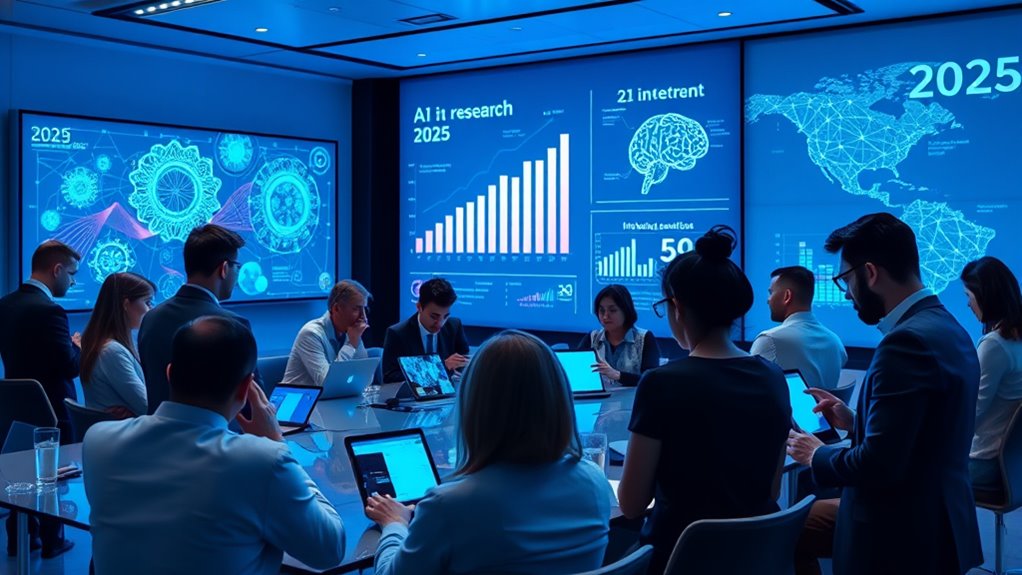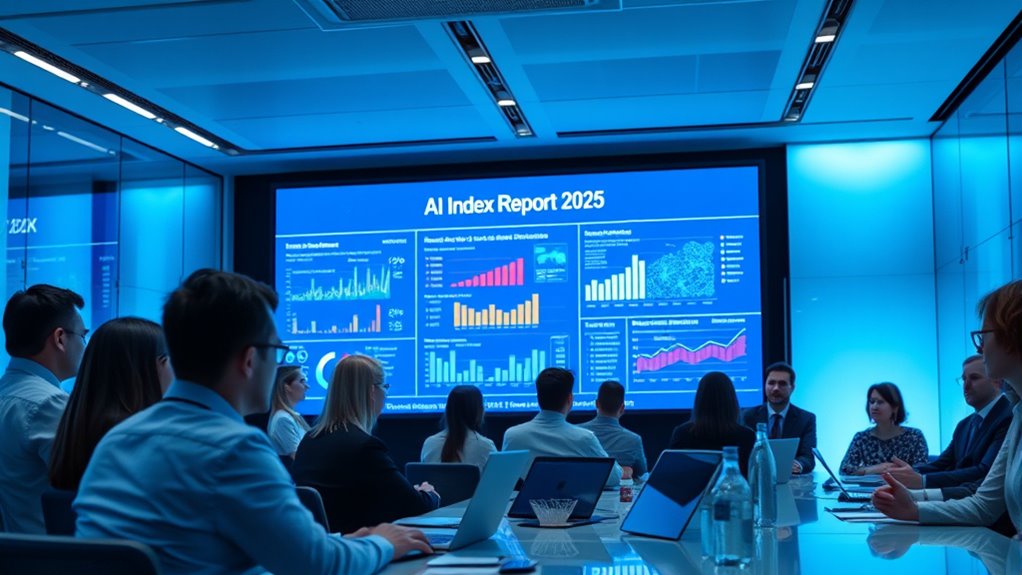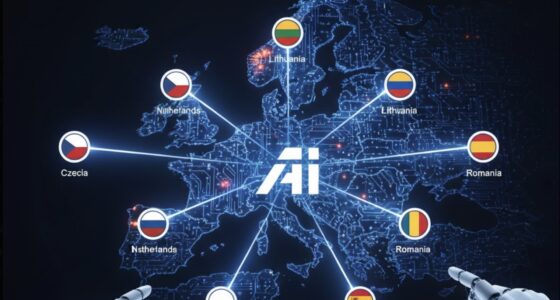The 2025 AI Index report highlights rapid progress in AI performance, with new benchmarks like MMMU and GPQA showing significant score increases, and systems often surpassing human abilities. AI is now widely adopted across sectors, from healthcare to autonomous vehicles, supported by record investment and innovation. However, challenges remain in security, ethics, and sustainability, prompting tighter regulations and smarter hardware solutions. Keep exploring to understand how these trends shape AI’s future landscape.
Key Takeaways
- AI benchmark scores in 2024 show significant advancements, with models surpassing human performance in complex tasks.
- Industry investment in AI surged, fueling rapid innovation across natural language processing, vision, and autonomous systems.
- AI-enabled applications in healthcare, transportation, and manufacturing gained regulatory approval and widespread deployment.
- Hardware innovations, including specialized accelerators and energy-efficient architectures, addressed rising training costs and sustainability.
- Concerns over AI security, privacy, and environmental impact prompted increased regulation and focus on ethical, responsible AI development.
Breakthroughs in AI Benchmarking and Performance Metrics

Recent advancements in AI benchmarking have considerably accelerated our understanding of system capabilities. In 2023, new benchmarks like MMMU, GPQA, and SWE-bench emerged to evaluate advanced AI skills more exhaustive. These tests measure complex reasoning, multitasking, and programming prowess. By 2024, scores improved dramatically—MMMU increased by 18.8 points, GPQA by 48.9 points, and SWE-bench by 67.3 points—highlighting rapid progress. AI systems now outperform humans in certain time-limited programming tasks, showcasing their growing technical competence. Additionally, high-quality video generation saw major breakthroughs, reflecting improvements in generative models. The continuous surpassing of existing benchmarks demonstrates how quickly AI capabilities are evolving, pushing boundaries and setting new standards for system performance assessment. Leveraging AI-driven insights has become essential for tracking progress and identifying areas for targeted improvement in AI research.
Real-World Adoption and Sector-Specific Deployments of AI

AI has increasingly become integral to various industries, transforming how healthcare, transportation, and manufacturing operate daily. In healthcare, AI-driven medical devices received FDA approval, enabling more accurate diagnoses and personalized treatments. Autonomous vehicles, like Waymo and Baidu’s Apollo Go, now provide thousands of daily rides, making self-driving technology more mainstream. Manufacturing benefits from AI for predictive maintenance and quality control, improving efficiency and reducing costs. These deployments shift AI from experimental projects to essential tools across sectors. You’ll find AI embedded in clinical workflows, logistics, and production lines. As adoption accelerates, organizations are leveraging AI to enhance safety, increase productivity, and deliver innovative services, marking a significant step toward a more automated, intelligent industrial landscape. Additionally, advancements in home automation technology are making AI-powered smart homes more accessible and user-friendly, further integrating AI into everyday life.
Trends in Business Investment and Innovation in Artificial Intelligence

You’ll notice that business investment in AI is surging, with more companies allocating significant funds to research and development. This increased funding is driving a sharp rise in patent activity, signaling rapid innovation. As a result, AI’s role in transforming industries becomes even more pronounced and competitive. Additionally, the emphasis on Beginners Guides and accessible resources is fueling broader adoption and understanding of AI technologies.
Growing Investment and Funding
Investors are pouring record-breaking amounts into artificial intelligence, fueling rapid innovation and expanding the technology’s reach across industries. Private funding hit new heights in 2024, with venture capital firms, corporate investors, and governments committing billions to AI startups and research initiatives. This influx accelerates product development, enabling companies to integrate AI into their offerings more quickly. Funding also supports foundational research, leading to breakthroughs in AI capabilities and new applications. As investment grows, so does competition among firms to develop the most advanced models and solutions. This surge in funding not only boosts innovation but also drives the commercialization of AI technologies, making them more accessible and influential across sectors. Additionally, the rise of AI-centric research and development efforts is fostering a more competitive environment, encouraging continuous improvement and innovation. Your organization can capitalize on this trend by aligning with emerging AI-driven opportunities.
Accelerating AI Patent Activity
The surge in funding for artificial intelligence has sparked a remarkable increase in patent activity, reflecting rapid innovation across the industry. You’ll notice that the number of AI-related patents filed worldwide continues to climb sharply, driven by corporate and academic efforts alike. Major tech firms, startups, and research institutions are actively securing intellectual property to protect their breakthroughs in areas like natural language processing, computer vision, and autonomous systems. This influx of patent filings signals a competitive race to establish technological leadership and monetize novel AI approaches. Furthermore, the rise in patent activity correlates with increased business investments, highlighting a strategic focus on safeguarding innovations. As a result, the pace of AI patenting underscores both the accelerating innovation cycle and the importance of intellectual property in shaping AI’s future landscape. AI patent activity also reflects the growing emphasis on generative AI applications, which are transforming content creation and entertainment industries.
Advances and Challenges in AI Training and Hardware Infrastructure

You’ll notice that AI training costs are climbing rapidly, putting pressure on resources and budgets. As energy consumption becomes a bigger concern, sustainable energy practices are gaining importance in infrastructure development. Hardware innovation trends, like specialized accelerators, aim to improve efficiency while managing these growing demands. Moreover, ongoing AI Security research emphasizes the need for robust safety measures to mitigate vulnerabilities in increasingly complex models.
Rising Training Costs
As AI models grow more complex and capable, training costs continue to escalate due to the increased computational resources required. You’ll notice that larger models demand more advanced hardware, often involving expensive accelerators and extensive data centers. This surge in resource needs drives up energy consumption, raising environmental concerns and operational expenses. While inference costs are decreasing, training remains costly, creating barriers for smaller organizations and researchers. To address this, industry leaders are exploring more efficient algorithms, model compression, and smarter hardware designs. Despite these efforts, balancing performance gains with financial and environmental sustainability remains a significant challenge. As training costs rise, you’ll see increased focus on optimizing resource use and developing scalable, cost-effective AI training solutions. Additionally, innovations in Kia Tuning techniques such as ECU remapping and lightweight components can inspire more energy-efficient hardware solutions for AI infrastructure.
Sustainable Energy Practices
Rising training costs have prompted the AI industry to seek sustainable energy practices to mitigate environmental impacts. You can see efforts to improve energy efficiency through optimized algorithms and smarter resource allocation. Data centers are adopting renewable energy sources like solar and wind, reducing reliance on fossil fuels. Companies are investing in carbon offset programs and exploring AI-specific hardware that consumes less power. Some organizations are implementing dynamic workload management to minimize energy waste during training. Despite these advances, challenges remain in scaling sustainable practices globally, especially in regions with limited renewable infrastructure. Additionally, incorporating natural materials and traditional design elements can help reduce the environmental footprint of data center construction and operation. Balancing the high computational demands of AI models with environmental responsibility requires ongoing innovation and policy support. Your role in adopting and promoting sustainable energy practices can help shape a greener AI future.
Hardware Innovation Trends
Have recent innovations in hardware markedly transformed AI training and infrastructure? Absolutely. You now see specialized accelerators, like TPUs and custom AI chips, designed to boost performance and energy efficiency. These advancements include:
- Development of next-generation AI accelerators, reducing training time and power consumption.
- Increasing adoption of heterogeneous computing architectures that combine CPUs, GPUs, and custom chips.
- Enhanced hardware-software integration, optimizing workloads for specific AI models.
- Growing focus on sustainable hardware solutions to address environmental concerns and reduce costs.
- Incorporating personality test insights to better tailor hardware solutions to diverse AI applications.
These trends enable faster training, lower costs, and more sustainable infrastructure. However, challenges remain, such as maintaining hardware scalability and balancing performance with energy use. Continuous innovation is essential to meet the growing demands of AI capabilities.
Security, Privacy, and Regulatory Developments in AI Governance

Security, privacy, and regulatory developments in AI governance have become critical as AI systems are increasingly integrated into everyday life. You need to stay vigilant as incidents related to AI security and data privacy surged by 56.4% in 2024, with 233 reported cases. Despite this, less than two-thirds of organizations actively manage AI risks, highlighting gaps in oversight. Meanwhile, regulatory frameworks are expanding; the U.S. more than doubled its oversight efforts, emphasizing compliance and responsible deployment. Public trust has declined slightly, signaling growing concerns over ethics and data handling. As AI’s influence grows, establishing robust governance frameworks and tighter data access controls becomes essential to mitigate risks, protect users, and ensure ethical AI development aligns with societal expectations. Incorporating advanced encryption solutions can help safeguard sensitive data and reinforce security measures in AI systems.
Societal Impacts and Policy Responses to AI Growth

As AI continues to expand its influence across economic, social, and governmental spheres, policymakers face increasing pressure to develop effective strategies for managing its societal impacts. You need to understand that this involves:
- Creating adaptive regulations that keep pace with rapidly advancing AI capabilities.
- Investing in public education to improve AI literacy and workforce preparedness.
- Promoting transparent AI development processes to build public trust.
- Ensuring equitable access to AI benefits across diverse communities and sectors.
These steps help balance innovation with societal safety, preventing misuse and addressing disparities. Governments worldwide are adopting data-driven approaches to craft targeted policies. Your role is vital in supporting responsible AI integration that benefits society while mitigating risks.
Ethical Considerations and the Future Outlook for AI Research

Ethical considerations are becoming central to AI research as advancements accelerate, prompting researchers and policymakers to confront critical questions about fairness, transparency, and accountability. You need to prioritize developing frameworks that assure AI systems avoid bias and promote equitable outcomes. As AI models grow more powerful, the importance of explainability and responsible deployment increases, demanding clear standards and oversight. You’ll also face challenges balancing innovation with privacy, especially with rising data security concerns and incidents. Future AI research must integrate ethical principles into design and evaluation processes. Collaboration across disciplines and sectors becomes essential, ensuring AI benefits society while minimizing harm. By proactively addressing these issues, you help shape a trustworthy, inclusive AI landscape that aligns with societal values and expectations.
Frequently Asked Questions
How Will AI Benchmarks Evolve Beyond 2025?
You’ll see AI benchmarks evolve rapidly beyond 2025 as new, more complex tests emerge to measure advanced capabilities. Expect benchmarks to incorporate real-world tasks like reasoning, creativity, and ethical decision-making, pushing AI systems to new heights. As AI abilities grow, benchmarks will become more dynamic, emphasizing robustness, fairness, and safety. This evolution will guide innovation, ensuring AI continues to meet societal needs while addressing performance, security, and ethical standards.
What Are the Long-Term Environmental Impacts of AI Development?
You should be aware that AI development’s long-term environmental impacts could include increased energy consumption, higher carbon emissions, and resource depletion due to training large models. However, efforts are underway to develop more sustainable practices, like utilizing renewable energy and optimizing hardware. If these initiatives succeed, you might see reduced environmental harm over time, but ongoing vigilance and innovation are vital to balancing AI progress with ecological responsibility.
How Is AI Regulation Shaping Global International Cooperation?
Imagine AI regulation as the modern equivalent of the Treaty of Westphalia, shaping global cooperation. You see, stricter rules and oversight foster international collaboration by establishing shared standards and accountability. Countries are increasingly working together to address AI safety, ethics, and security concerns. This unified approach helps prevent conflicts, promotes responsible innovation, and builds trust—making AI a tool for global progress rather than division.
What Measures Are Most Effective in Mitigating AI Security Risks?
You can effectively mitigate AI security risks by implementing robust governance frameworks, regular risk assessments, and extensive security protocols. Prioritize active monitoring of AI systems for vulnerabilities and establish clear accountability measures. Encouraging transparency and collaboration among organizations helps share best practices. Additionally, staying updated on evolving regulations and fostering AI literacy across teams ensures responsible deployment, reducing vulnerabilities and building trust in AI technologies.
How Can AI Ensure Equitable Benefits Across Diverse Populations?
Like a bridge connecting distant shores, AI can guarantee equitable benefits by prioritizing inclusive data, diverse team collaboration, and fairness algorithms. You can advocate for policies that require transparency and accountability in AI systems, making sure underserved populations are considered. By fostering community engagement and continuous monitoring, you help prevent biases and promote equal access, so AI becomes a tool that lifts everyone, not just a select few.
Conclusion
As you follow AI’s rapid progress, remember that over 300 AI startups emerged last year alone, fueling innovation and competition. This surge highlights just how quickly the landscape is evolving. Staying informed helps you understand AI’s potential to transform industries and society. Keep an eye on ongoing breakthroughs and challenges—your awareness can shape how you adapt and leverage AI’s future opportunities. The pace is swift; now’s the time to stay engaged.









